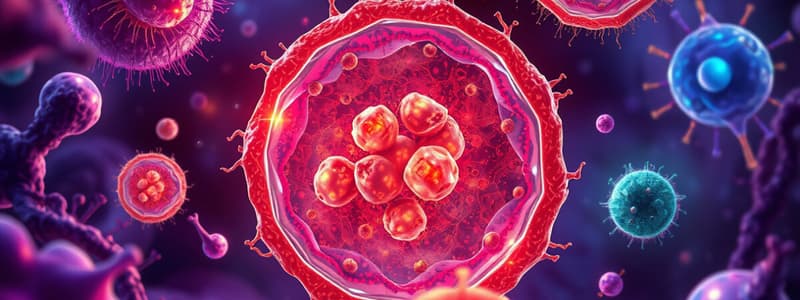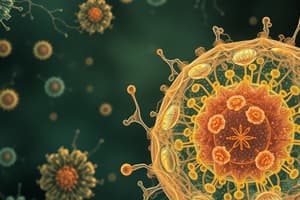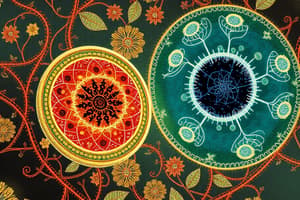Podcast
Questions and Answers
Who was the first to witness live cells under a microscope?
Who was the first to witness live cells under a microscope?
- Robert Hooke
- Rudolph Virchow
- Matthias Schleiden
- Anton Van Leeuwenhoek (correct)
Which statement is part of the General Cell Theory?
Which statement is part of the General Cell Theory?
- All living organisms are unicellular.
- All cells are identical in structure and function.
- Cells are the smallest working unit of all living things. (correct)
- Cell division is unique to prokaryotic cells.
Which of the following is a feature of prokaryotic cells?
Which of the following is a feature of prokaryotic cells?
- Presence of organelles
- Presence of a membrane-bound nucleus
- Lack of a membrane-bound nucleus (correct)
- Larger size compared to eukaryotic cells
What is the primary function of ribosomes in eukaryotic cells?
What is the primary function of ribosomes in eukaryotic cells?
What does the rough endoplasmic reticulum (Rough ER) contain that distinguishes it from smooth ER?
What does the rough endoplasmic reticulum (Rough ER) contain that distinguishes it from smooth ER?
What structure regulates the entry and exit of substances in prokaryotic cells?
What structure regulates the entry and exit of substances in prokaryotic cells?
What is the primary function of the nucleolus in eukaryotic cells?
What is the primary function of the nucleolus in eukaryotic cells?
Which of the following organisms would be classified as eukaryotic?
Which of the following organisms would be classified as eukaryotic?
What did Rudolph Virchow contribute to cell theory?
What did Rudolph Virchow contribute to cell theory?
What is the main structural difference between prokaryotic and eukaryotic cells?
What is the main structural difference between prokaryotic and eukaryotic cells?
What is the primary function of the Golgi Apparatus?
What is the primary function of the Golgi Apparatus?
Which component of the cytoskeleton is responsible for cell motion?
Which component of the cytoskeleton is responsible for cell motion?
What role do lysosomes play in the cell?
What role do lysosomes play in the cell?
Which structure is known as the powerhouse of the cell?
Which structure is known as the powerhouse of the cell?
What is the function of microvilli in the cell membrane?
What is the function of microvilli in the cell membrane?
Which type of integral protein allows specific molecules to pass through the cell membrane?
Which type of integral protein allows specific molecules to pass through the cell membrane?
Which of the following is NOT a function of the vacuole?
Which of the following is NOT a function of the vacuole?
What type of proteins are involved in speeding up chemical reactions in the cell membrane?
What type of proteins are involved in speeding up chemical reactions in the cell membrane?
Which component of the cell membrane provides protection and aids in cell recognition?
Which component of the cell membrane provides protection and aids in cell recognition?
What role does the centrosome play in the cell?
What role does the centrosome play in the cell?
Flashcards are hidden until you start studying
Study Notes
Cell Theory Development
- Robert Hooke (1665): Discovered and named cells while examining cork.
- Anton Van Leeuwenhoek (1674): First to observe live cells, termed moving organisms as "animalcules."
- Matthias Schleiden (1838): Established that all plants consist of cells.
- Theodor Schwann (1839): Confirmed that all animals are made up of cells.
- General Cell Theory: Established that the cell is the basic structural and functional unit of all living organisms.
- Rudolph Virchow (1855): Proposed that all cells originate from pre-existing cells through division.
Summary of Cell Theory
- All living organisms consist of cells.
- Cells are the smallest unit of life.
- All cells arise from existing cells via cell division.
Types of Cells
-
Prokaryotic Cells:
- Do not have a membrane-bound nucleus.
- Found in Bacteria and Archaea; generally smaller than eukaryotic cells.
- Key components include:
- Cell membrane: Regulates entry and exit of substances.
- Cytoplasm: Fluid filling the cell.
- Ribosomes: Sites for protein synthesis.
- Cell wall: Provides structural support.
- Pili: Helps cells attach to surfaces.
- Flagella: Enables movement in some prokaryotes.
-
Eukaryotic Cells:
- Have a membrane-bound nucleus.
- Larger than prokaryotic cells, with organelles performing specialized functions.
- Located in the domain Eukarya.
Eukaryotic Cells - Focus on Animal Cells
- Nucleus: Directs cell division and metabolic activities; contains chromatin.
- Nucleolus: Site for ribosome production.
- Ribosome: Synthesizes proteins; consists of small spherical bodies.
- Vesicle: Transports molecules, secretes substances, digests materials.
- Endoplasmic Reticulum:
- Rough ER: Studded with ribosomes; involved in protein synthesis and membrane production.
- Smooth ER: Lacks ribosomes; synthesizes hormones and lipids.
- Golgi Apparatus: Modifies, packages, and distributes substances from the ER.
- Cytoskeleton: Maintains cell shape; includes:
- Microfilaments: Involved in cell movement.
- Microtubules: Support cell shape and movement of chromosomes.
- Intermediate Filaments: Provide structural support.
- Mitochondrion: Produces ATP; has a double membrane with inner folds (cristae).
- Vacuole: Functions in storage, digestion, and regulating cell pressure.
- Cytosol & Cytoplasm:
- Cytosol: Fluid part of the cytoplasm.
- Cytoplasm: Protoplasm surrounding the nucleus.
- Lysosome: Acts as waste disposal; involved in digestion and cell autophagy.
- Centrosome: Plays a key role in cell division.
- Cell Membrane: Semi-permeable, composed of proteins and lipids; regulates cellular substance movement.
Functions of Integral Proteins in the Cell Membrane
- Channel proteins: Facilitate selective passage of molecules.
- Carrier proteins: Assist in transport across membranes.
- Cell recognition proteins: Enable cell identification.
- Receptor proteins: Detect external chemical signals.
- Enzymatic proteins: Catalyze biochemical reactions.
- Cytoskeleton anchor proteins: Attach cytoskeleton elements to the membrane.
Cell Membrane Modifications
- Microvilli: Increase surface area for absorption.
- Glycocalyx: Provides protective coating and aids in cell recognition.
- Cell Wall: Present in plant cells, offering structural support.
Studying That Suits You
Use AI to generate personalized quizzes and flashcards to suit your learning preferences.




